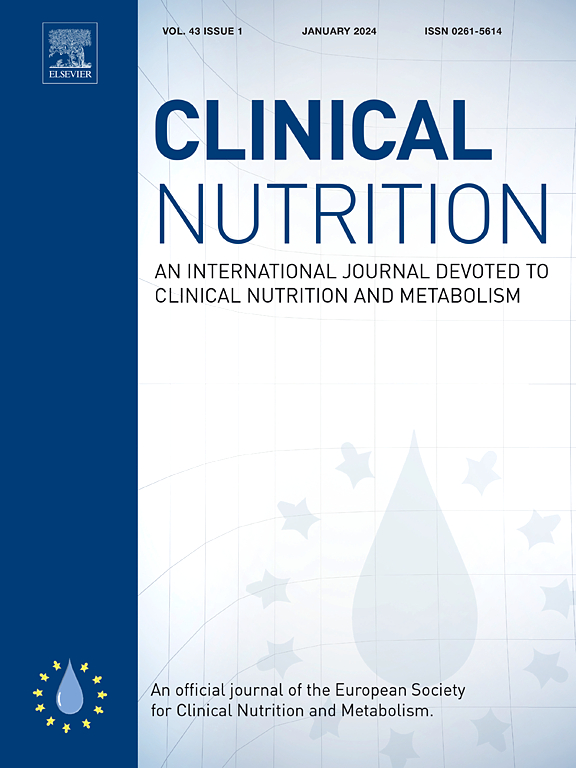解读无意减肥:正确的问题如何产生影响
IF 6.6
2区 医学
Q1 NUTRITION & DIETETICS
引用次数: 0
摘要
背景/目的小营养筛查工具通常包括有关非故意体重减轻(UWL)的问题。目前尚不清楚那些有意减肥或认为自己超重的人是否准确地解释了有关UWL的问题。我们评估了这些组中与uwl相关问题的潜在错误分类。方法使用来自lifeline队列的数据(ñ125.000,年龄18岁)。患病率(pr)是通过一个简单的问题来计算的,以UWL为因变量,减肥的愿望和对体重的感知(太重vs.刚刚好/太轻)为独立的自变量。根据体重指数(BMI)分组(正常体重vs超重/肥胖)对相关进行分层,并根据各种合并症、人口统计学和生活质量进行调整。结果:在体重正常的参与者中,30.3%的人希望减肥,37.9%的人认为自己的体重过重,5.1%的人报告UWL;超重/肥胖组分别为80.1%、92.7%和2.7%。在两个BMI组中,希望减肥或认为自己过重的参与者的UWL患病率降低了约60%(患病率比0.40-0.43,p值<;0.05)。结论由于减肥的愿望或对体重的感知并没有逻辑基础来预防UWL,因此报告的UWL相关问题患病率较低可能是误解的结果。包括UWL问题的营养不良筛查工具可能低估了高bmi人群中营养不良的患病率,因为这些人群中的个体往往渴望减肥或认为自己太重。本文章由计算机程序翻译,如有差异,请以英文原文为准。
Decoding unintentional weight loss: How the right questions make a difference
Background/aims
Malnutrition screening tools often include questions about unintentional weight loss (UWL). It is unclear whether individuals who intentionally desire to lose weight or perceive themselves as overweight interpret questions regarding UWL accurately. We assessed potential misclassification of UWL-related questions in these groups.
Method
Data from the Lifelines cohort was used (ñ125.000, age >18 years). Prevalence ratios (PRs) were calculated with a simple question regarding UWL as the dependent variable and the desire to lose weight and perception of one's body weight (too heavy vs. just right/too light) as separate independent variables. Associations were stratified by body mass index (BMI) group (normal weight vs. overweight/obesity) and adjusted for various comorbidities, demographics, and quality of life.
Results
Of participants with normal weight, 30.3 % desired to lose weight, 37.9 % perceived their body weight as too heavy and 5.1 % reported UWL; this was 80.1 %, 92.7 % and 2.7 % for those with overweight/obesity. In both BMI groups, the prevalence of UWL was ∼60 % lower in participants who desired to lose weight or perceived themselves as too heavy (prevalence ratios 0.40–0.43, p-value <0.05).
Conclusion
Since there is no logical basis for the desire to lose weight or one's perception of body weight to prevent UWL, lower reported prevalence rates on UWL-related questions are likely the result of misinterpretation. Malnutrition screening tools that include questions regarding UWL might underestimate the prevalence rates of malnutrition in higher BMIs, as individuals in these groups often aspire to lose weight or perceive themselves as too heavy.
求助全文
通过发布文献求助,成功后即可免费获取论文全文。
去求助
来源期刊

Clinical nutrition
医学-营养学
CiteScore
14.10
自引率
6.30%
发文量
356
审稿时长
28 days
期刊介绍:
Clinical Nutrition, the official journal of ESPEN, The European Society for Clinical Nutrition and Metabolism, is an international journal providing essential scientific information on nutritional and metabolic care and the relationship between nutrition and disease both in the setting of basic science and clinical practice. Published bi-monthly, each issue combines original articles and reviews providing an invaluable reference for any specialist concerned with these fields.
 求助内容:
求助内容: 应助结果提醒方式:
应助结果提醒方式:


